|
|
Leaching Behavior and Mechanism of Ceramic Waste Forms
Ya-Ping SUN, Hong-Long WANG, Jian CHU, Xu WANG, She-Qi PAN, Ming ZHANG
2019 Vol. 34 (5): 461–468
 Abstract
Abstract(
766 )
 HTML
HTML(
24)
 PDF
PDF(1051KB)(
899
)
The radionuclides in high-level radioactive waste (HLW) forms may be leached out over geological time and enter the human environment with groundwater circulation after deep geological disposal. This is likely the potential way for radionuclides to enter the biosphere. Therefore, the long-term chemical durability of HLW waste forms is the key issue for selecting suitable waste forms. Ceramic waste forms, regarded as the second generation of HLW forms, are of long-range ordered structures, whose physical properties can be easily characterized quantitatively. It is of great importance and significance to study the leaching mechanism of ceramic waste forms. However, not only the studies of leach mechanisms, but also the evaluation methods of ceramic waste forms are in their infancy. There is also lack of the standards of ceramic waste forms received by the repository. The present paper summarizes the research methods and key points of chemical durability, reviews the research status of hydrothermal alteration of related ceramics, and analyzes the leaching rate of radionuclides. In addition, the paper also discusses the influencing factors and their influencing modes, and finally concludes the leaching mechanisms and existing problems.
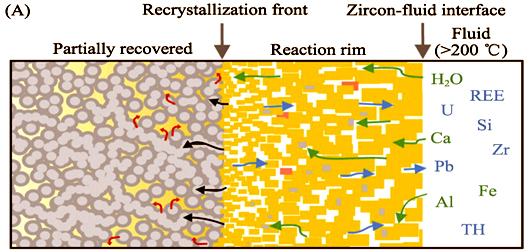
|
|
|
Preparation and Mechanical Property of Graphene-reinforced Copper Matrix Composites
Zheng-De LIN, Sheng-Cheng SHU, Ao LI, Ming-Liang WU, Ming-Yang YANG, Yu HAN, Zhi-Xiang ZHU, Bao-An CHEN, Yi DING, Qiang ZHANG, Qiang WANG, Dan DAI
2019 Vol. 34 (5): 469–477
 Abstract
Abstract(
1346 )
 HTML
HTML(
62)
 PDF
PDF(1824KB)(
2115
)
Graphene, which has two-dimensional carbon single atomic layer, attracts great attention due to its superb mechanical, electrical and thermal properties. In addition to its excellent mechanical properties, a large surface area (about 2600 m 2?g -1) makes it an ideal reinforcement for copper-based composites. However, graphene owns a low density (2.2 g?cm -3), while the density of copper is about 8.9 g?cm -3. The traditional powder metallurgy process is difficult to solve the problem of uniform dispersion of graphene in the copper matrix and the poor bonding strength between graphene and copper due to the huge density difference between copper and graphene. With the in-depth exploration in the issue of graphene/copper interface in recent years, some novel preparation processes and strengthening mechanisms were proposed and demonstrated. This review systematically introduces and compares the recently-developed preparation processes of graphene-reinforced copper composites, also summarizes the mechanism of mechanical enhancement in graphene-reinforced copper matrix composites.
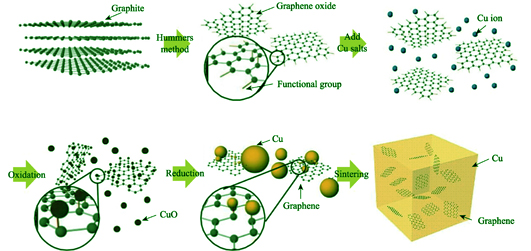
|
|
|
Preparation and Property of Polyethersulfone Ultrafiltration Membranes with Mesoporous-graphitic-C3N4/Ag
Zi-Ya LIU, Ru-Ya CAO, Man-Ying ZHANG
2019 Vol. 34 (5): 478–486
 Abstract
Abstract(
665 )
 HTML
HTML(
19)
 PDF
PDF(1231KB)(
1114
)
Membrane fouling is still the major problem for the application of membrane separation. In this study, different amounts of silver doped mesoporous graphitic carbon nitride (m-g-C3N4/Ag) were introduced into casting solution by blending. The polyethersulfone (PES) nanocomposite membrane was prepared via the phase-inversion method. The impacts of m-g-C3N4/Ag addition on the morphology, filtration, antibacterial, photocatalytic, and antifouling properties of nanocomposite membrane were systematically studied. The results showed that the addition of m-g-C3N4/Ag can improve the cross-section structure of the nanocomposite membrane as well as its surface hydrophilicity. Compared with pure PES membrane, the pure water flux of the modified nanocomposite membrane increased significantly with the increase of doping amount. The protein rejection rates of all samples were over 90%, indicating that the addition of m-g-C3N4/Ag can significantly improve the filtration performance of the nanocomposite membrane without sacrificing the rejection performance. The anti-bacterial activity of the nanocomposite membranes was improved with the increase of m-g-C3N4/Ag content in which the anti-bacterial activity to P. aeruginosa was much more significant than that to E. coli. The pure PES membrane almost had not photodegradation under light irradiation. By contrast, all nanocomposite membranes exhibited good photocatalytic properties under visible light irradiation, and the photocatalytic activity improved with increase of m-g-C3N4/Ag. The nanocomposite membrane in which the m-g-C3N4/Ag content was the highest that showed the optimal photocatalysis, and the decolorization rate of methyl orange reached 63% in 120 min. The comprehensive antifouling performances of all membranes were characterized by four-step filtration experiments. It can be seen that the flux recovery ratio (FRR) of all nanocomposite membranes is much higher than that of PES membrane. The FRR of all membranes was further increased after washing with water and irradiating with visible light. In summary, the addition of m-g-C3N4/Ag can endow the PES membrane with the antibacterial and the photocatalytic properties under visible light irradiation, thereby improving its comprehensive antifouling performance.
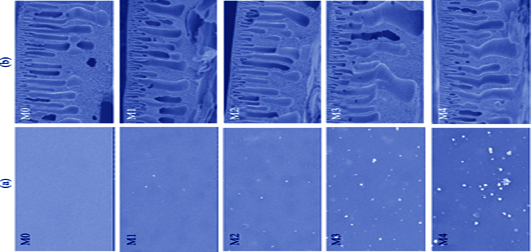
|
|
|
Co3O4 Nanowire Arrays@Activated Carbon Fiber Composite Materials: Facile Hydrothermal Synthesis and Its Electrochemical Application
Wei LIU, Kai ZHENG, Dong-Hong WANG, Yi-San LEI, Huai-Lin FAN
2019 Vol. 34 (5): 487–492
 Abstract
Abstract(
622 )
 HTML
HTML(
17)
 PDF
PDF(839KB)(
956
)
Co3O4@activated carbon fibers (ACF) composites were prepared through a facile hydrothermal method followed by calcination process, involving the growth of Co3O4 nanowires on ACF surface. Co(NO3)2·6H2O was used as Co source, urea and NH4F as additives. The structures and morphologies of Co3O4@ACF composites were characterized by scanning electron microscopy (SEM), X-ray diffraction (XRD), N2 adsorption/desorption measures, and thermogravimetric analysis (TGA). The electrochemical properties of Co3O4@ACF composites were investigated by cyclic voltammetry (CV), galvanostatic charge discharge (GCD) and electrochemical impedance spectroscopy (EIS). The results showed that Co3O4 nanowire arrays uniformly grew on the surface of ACF along the vertical direction, forming abundant mesoporous structures. Co3O4@ACF composites with various Co3O4 fractions could be obtained by adding different amount of Co(NO3)2·6H2O. Furthermore, Co3O4@ACF composite with 47wt% Co3O4 fraction exhibited a high specific capacitance of 566.9 F/g at a current density of 1 A/g, which was almost twice as high as that of pure Co3O4. Even at 15 A/g, the composite still delivered a specific capacitance of 393.3 F/g, showing good rate capability. The specific capacitance of the composite could retain 84.2% of initial value after 5000 charging/discharging cycles, which indicates its superior cycling stability.
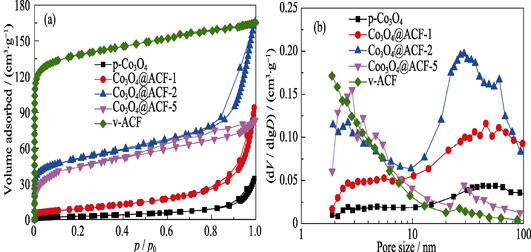
|
|
|
Boron-carbon doped Silicon Carbide Fibers: Preparation and Property
Han-Qing YU, Zhi-Jun DONG, Guan-Ming YUAN, Ye CONG, Xuan-Ke LI, Yong-Ming LUO
2019 Vol. 34 (5): 493–501
 Abstract
Abstract(
824 )
 HTML
HTML(
27)
 PDF
PDF(9663KB)(
1086
)
The B-C doped SiC precursor was obtained by blending of polycarbosilane, polyborosilicate and xylene soluble pitch at low temperature. The resulted precursor was melt-spun into precursor fibers. The B-C doped silicon carbide fibers were finally obtained by pre-oxidation and high temperature heat-treatment of the precursor fibers successively. The composition and microstructure of B-C doped SiC precursor and its fibers were characterized by IR, XRD and SEM. Effect of the heat-treatment temperature on the composition, structure, mechanic property and oxidation resistance was studied. The results show that the introduction of boron in SiC fibers restrains the growth of SiC grains at high temperature treatment effectively, and simaltaneously improves the thermal stability of the C-doped SiC fibers. B-C doped silicon carbide fibers obtained by heating the pre-oxidized fibers at 1600 ℃ were mainly composed of β-SiC and a small amount of O, B and N. B-C doped SiC fibers ownse better oxidation resistance than the C-doped SiC fibers, which can be attributed to the formation of borosilicate film during the high-temperature oxidation of the B-C doped SiC fibers. This film plays a role effectively in preventing the pith carbon in the doped fibers from oxidation.
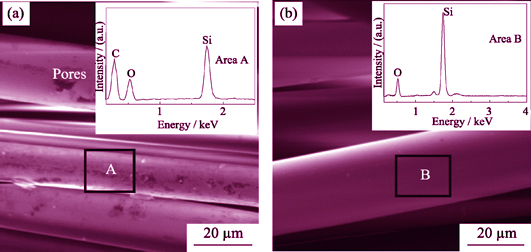
|
|
|
Controllable Preparation of Co-NC Nanoporous Carbon Derived from ZIF-67 for Advanced Lithium-sulfur Batteries
Shi-Qiang LUO, Chun-Man ZHENG, Wei-Wei SUN, Wei XIE, Jian-Huang KE, Shuang-Ke LIU, Xiao-Bin HONG, Yu-Jie LI, Jing XU
2019 Vol. 34 (5): 502–508
 Abstract
Abstract(
1169 )
 HTML
HTML(
37)
 PDF
PDF(2340KB)(
1605
)
This work reported a facile strategy for preparing S/Co-NC composite sulfur cathode materials with different Co loadings derived from ZIF-67, which were applied as cathode materials for Li-S batteries. SEM and TEM were used to observe the morphology and pore structure of Co-NC composite. XRD analysis was employed to investigate the crystalline state of cobalt embedded in porous carbon materials. N2 adsorption-desorption techniques was used to characterize the BET surface area and pore volume of Co-NC samples. Experimental results showed that the Co-NC with Co content of 15.93wt% exhibited the superior electrochemical performance. The cathode equipped with optimized composite showed a high capacity retention rate of 94.84% between 50 th to 200 th cycles at 0.2C current density, and even at high current density (5.0C), a high discharge capacity of 718.8 mAh?g -1 could still be obtained.
|
|
|
A Direct Carbon Solid Oxide Fuel Cell Stack Based on a Single Electrolyte Plate Fabricated by Tape Casting Technique
Wei WANG, Li-Li YUAN, Qian-Yuan QIU, Ming-Yang ZHOU, Mei-Lin LIU, Jiang LIU
2019 Vol. 34 (5): 509–514
 Abstract
Abstract(
489 )
 HTML
HTML(
8)
 PDF
PDF(1633KB)(
634
)
A direct carbon solid oxide fuel cell stack based on a single electrolyte plate was proposed and investigated for applications in small-scale power supplies. YSZ electrolyte plates were fabricated through tape casting technique. Small holes, contributing to electrical connection between the electrodes on opposite sides of the electrolyte, were punched on the green electrolyte plates. A stack with four cells electrically connected in series was prepared, whose total effective area was 5.6 cm 2. The 4-cell-stack was tested with 5 g Fe-loaded (5wt%) activated carbon as fuel and ambient air as oxidant. The stack gave an open circuit voltage of 3.80 V and the a peak power of 1.66 W, corresponding to a power density of 296 mW×cm -2 at 850 ℃. Meanwhile, the peak power density of the first cell of the stack was 294 mW×cm -2, suggesting good consistency among the four cells constituting the stack. The stack discharged at a constant current of 300 mA for 11 h at 800 ℃, giving a discharging energy of 8.42 W×h and fuel utilization of 30%. This work shows the promise of developing DC-SOFCs for portable and distributed applications.
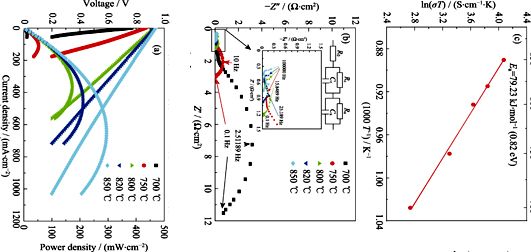
|
|
|
Sb-doped Tin Oxide Thin Film: Preparation and Effect on Cooling Silicon Solar Cells
Ce LI, Shuang CHEN, Rui-Qian-Ling GAO, Ran LI, Cheng-Yi HOU, Hong-Zhi WANG, Hua-Qing XIE, Qing-Hong ZHANG
2019 Vol. 34 (5): 515–520
 Abstract
Abstract(
682 )
 HTML
HTML(
17)
 PDF
PDF(2065KB)(
751
)
Silicon-based solar cells occupy the largest share of photovoltaic industry, but their efficiency decreases due to the high operating temperatures under sunlight, which reduces their power output. Thus, cooling the silicon based solar cells under irradiation is very important. In this study, Sb-doped tin oxide ATO thin films, working as the cover plate of silicon-based solar cells, were deposited on glass substrates by Sol-Gel spin-coating method, with SnCl2·H2O and SbCl3 as raw materials. Influence of Sb doping and film thickness on the heat shielding property and the performance of solar cells were investigated. As a result, the shielding performance of the ATO films was improved with the increase of the thickness, while its transmittance reduces with the increase of the thickness. Compared with ordinary glass cells, temperature of solar cells with spin-coated ATO thin films of 1 to 4 layers decreases by 2.7 ℃, and their efficiency keeps over 10.79% after being irradiated by AM1.5 solar simulator for 30 min. What’s more, the ATO doped with 10mol% Sb performs the best thermal insulation. Efficiency of silicon solar cell covered with 10mol% Sb-doped ATO film increases by 0.43% as compared with blank after being irradiated by solar simulator for 30 min.
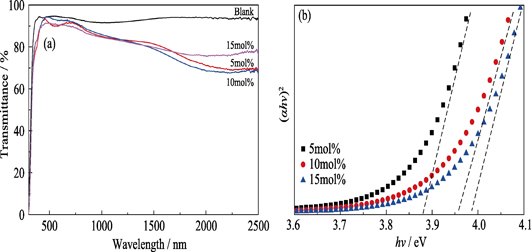
|
|
|
Effect of Sr Doping on Electrical Transport and Emission of 12CaO·7Al2O3 Electride
Wei-Kang ZHAO, Xin ZHANG, Qi FENG, Ji-Ping ZHAO, Hong-Liang LIU, Fan LI, Yi-Xin XIAO, Yan-Qin LIU, Jiu-Xing ZHANG
2019 Vol. 34 (5): 521–528
 Abstract
Abstract(
477 )
 HTML
HTML(
19)
 PDF
PDF(1878KB)(
851
)
[Ca24Al28O64] 4+:4e -(C12A7:e -) is a new cathode material with low working temperature and low work function, and its unique cage structure attracts attention of researchers. In this work, the Sr doped (C1-xSx)12A7:e -(0≤x≤0.05) were prepared by high temperature solid phase reaction combined with spark plasma sintering (SPS), and the electron compound (Ca1-xSrx)12A7:e - was successfully obtained by reduction of Ti particles at 1100 ℃ for 20 h. The first principle calculations for electronic structure show that Sr doping changes the band structure of C12A7:e -, the Framework Conduction Band (FCB) decreases to 0.3 eV, benefits the electrical properties of (Ca1-xSrx)12A7:e -. The total density of states (DOS) of (Ca1-xSrx)12A7:e -near the Fermi energy level is increased. The electrical transport characteristics test results show that the (Ca0.96Sr0.04)12A7:e - has the highest conductivity 1136 S/cm and carrier concentration (2.13±0.11)×10 21 cm -3, indicating that Sr doping is benefical for reducing the preparation time of mayenite electride. The thermionic emission performance test results show that Sr doping significantly increases the emission current density and effectively reduces the average effective work function. The (Ca0.96Sr0.04)12A7:e - has the best emission performance, and the emission current density reaches 1.45 A/cm 2 at 1100 ℃ and a anode voltage of 3500 V. The Zero field emission current density is 0.74 A/cm 2, and the Richardson work function reduces from 2.01 eV (un-doped) to 1.86 eV.
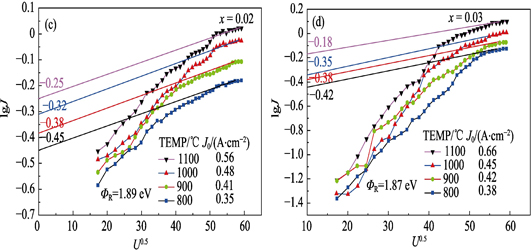
|
|
|
Comparative Study of Cu2ZnSnS4 Thin Films Prepared by Chalcogenide and Single Targets
Xin XU, Shu-Rong WANG, Xun MA, Shuai YANG, Yao-Bin LI, Hong-Bin YANG
2019 Vol. 34 (5): 529–534
 Abstract
Abstract(
466 )
 HTML
HTML(
7)
 PDF
PDF(9147KB)(
916
)
To verify feasibility and superiority of preparing Cu2ZnSnS4 (CZTS) thin films and solar cells by sputtering chalcogenide targets instead of single targets, two kinds of CZTS thin films were synthesized via multi-period sputtering ZnS-Sn-CuS and Zn-Sn-Cu, respectively. Influence of different sputtering targets on crystal structure, phase purity, surface roughness, chemical composition, surface and cross-sectional morphology, and optical-electrical properties of CZTS thin films were investigated in detail. Subsequently, the complete devices were fabricated according to SLG/Mo/CZTS/CdS/i-ZnO/ZnO:Al/Ni-Al and J-V characteristics of cells were measured. The results show that the solar cell made of ZnS-Sn-CuS precursor owns an open-circuit voltage of 611 mV, short-circuit current density of 21.28 mA/cm 2 and efficiency of 5.11% while the solar cell based on single targets shows an open-circuit voltage of 594 mV, short-circuit current density of 18.56 mA/cm 2 and an efficiency of 4.13%. It is attributed to the fact that the CZTS thin films prepared by ZnS-Sn-CuS have smoother, denser surface and better longitudinal growth compared with those prepared by single targets. The result confirms the superiority of the CZTS thin film and solar cells prepared using the chalcogenide targets over those from single targets.
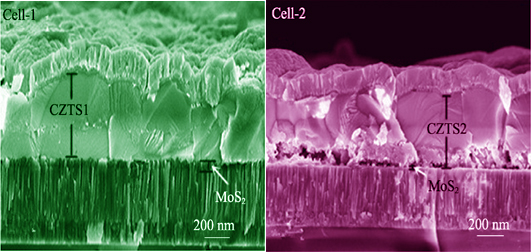
|
|
|
Surface Modification by Stearic Acid on Property of PLZT Piezoelectric Ceramics Prepared via Powder Injection Molding
Dun WU, Shuai QIN, Chun-Lin LIU, Bi-Jun FANG, Zheng CAO, Jun-Feng CHENG
2019 Vol. 34 (5): 535–540
 Abstract
Abstract(
624 )
 HTML
HTML(
8)
 PDF
PDF(4872KB)(
918
)
A powder injection molding feedstock of lead zirconate titanate (PLZT) was successfully prepared using stearic acid as powder modifier and polyethylene glycol/polyvinyl butyral/polyoxymethylene (PEG/PVB/POM) as binder system. Then, PLZT piezoelectric ceramics were prepared by degreasing and post-sintering processes. The effects of stearic acid (SA) dosage on powder properties, feedstock viscosity, water degreasing rate and green body strength were studied. The microstructure and electrical properties of the sintered ceramics were compared and analyzed. The results showed that stearic acid was successfully coated onto the PLZT powder by wet modification. The modification of stearic acid broke the agglomeration between the powders, and when the amount of stearic acid was 2wt%, the feedstock had a lower shear viscosity and a higher green body bending strength. However, excessive modification caused the feed viscosity to increase and the bending strength of the green body to decrease. The modified powder was uniformly dispersed in the body, and the sintered ceramic had higher density with well grown grains. As compared to the unmodified sample, the piezoelectric constant d33 of the PLZT modified with 2wt% SA increased from 638 pC/N to 682 pC/N.
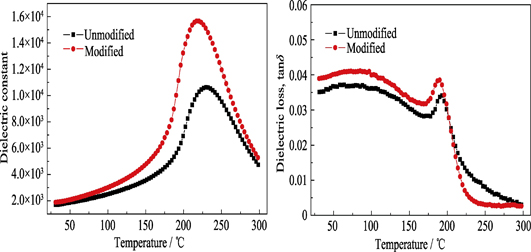
|
|
|
Preparation of La2NiMnO6 Double-perovskite Ceramics by Plasma Activated Sintering
Hui GAN, Chuan-Bin WANG, Qiang SHEN, Lian-Meng ZHANG
2019 Vol. 34 (5): 541–545
 Abstract
Abstract(
567 )
 HTML
HTML(
19)
 PDF
PDF(1441KB)(
643
)
La2NiMnO6 (LNMO) double-perovskite ceramics are normally prepared by the conventional pressureless sintering technique, which is difficult to produce dense structure and usually needs high sintering temperature as well as long sintering period. In this study, highly-dense La2NiMnO6 ceramics with good performance were prepared by a novel Plasma Activated Sintering (PAS) method. The influence of PAS parameters, including sintering temperature and pressure, on crystalline phase, microstructure, relative density and dielectric properties of the LNMO ceramics were systematically studied by the means of XRD, SEM, Archimedes method, and impedance analyzer. The results showed that the crystallinity and grain size of the LNMO ceramics increased with the increase of sintering temperature, but the impurity phases might emerge if the sintering temperature further increased above 1000 ℃. The sintering pressure had little effect on crystalline phase, while the relative density of the LNMO ceramics could be effectively enhanced with the sintering pressure increasing. LNMO ceramics in single orthorhombic structure with relative density of 92% and giant dielectric constant (~10 6) were successfully obtained at the optimum PAS conditions, i.e., sintering temperature of 975-1000 ℃ and sintering pressure of 80 MPa. Compared to the traditional pressureless sintering, LNMO ceramics with dense structure could be obtained by PAS at a relative lower sintering temperature (reduced by 400-500 ℃) with a shorter sintering period (reduced by 2-20 h), which should be attributed to the coupling effect of temperature and stress as well as activation during the sintering process.
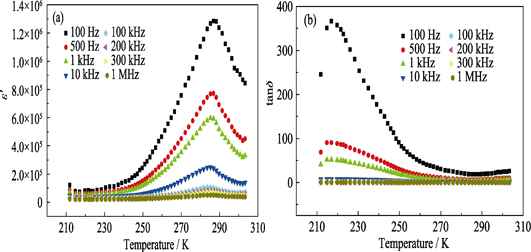
|
|
|
Catalystic Performance of HZSM-5 Zeolite Treated by CH3COONa
Guo-Hao XU, Jin-Peng YU, Hua-Sheng XU, Chun-Cheng LI, Jin-Hua HUANG, Peng-Fei WANG
2019 Vol. 34 (5): 546–552
 Abstract
Abstract(
570 )
 HTML
HTML(
13)
 PDF
PDF(3207KB)(
1084
)
HZSM-5 zeolites were treated by CH3COONa solution with different concentrations and conventional alkali (NaOH or Na2CO3) solution. Then, Pt was loaded on HZSM-5 zeolites before and after the treatment to synthesize Pt/HZSM-5 catalysts for propane dehydrogenation reaction. HZSM-5 zeolites were characterized by XRD, XRF, SEM, BET, NH3-TPD, and H2 chemisorption. The effect of CH3COONa solution with different concentrations and conventional alkali solution on crystal structure, surface morphology, pore structure, surface acidity, and propane dehydrogenation performance of HZSM-5 zeolites were investigated. The results showed that CH3COONa solution modified HZSM-5 zeolites by alkali. Compared with conventional alkali solution, the treatment of CH3COONa solution for HZSM-5 zeolites could more effectively introduce and better controllably the mesoporous structure with less influence on the crystal structure and surface morphology. With increase of the concentration of CH3COONa solution, the initial propane conversion and the propene selectivity in propane dehydrogenation firstly increased and then decreased. The catalyst treated by 4.0 mol/L CH3COONa solution exhibited the highest propane initial conversion and propene selectivity, which were 34.5% and 98.9%, respectively.
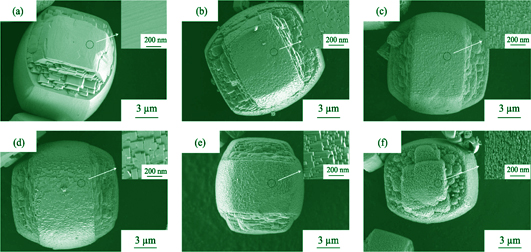
|
|
|
3D Hierarchical Flower Like Alumina Nanomaterials: Preparation and Arsenic Removal Performance
Rong-Hui LI, Yi-Zheng JIA, Nan-Nan HU
2019 Vol. 34 (5): 553–559
 Abstract
Abstract(
607 )
 HTML
HTML(
14)
 PDF
PDF(1392KB)(
1076
)
A 3D flower-like active alumina material was synthesized through a simple hydrothermal method following by calcination at 500 ℃. This structure retains abundant nanoscale active sites and micro-scale 3D size. In the column adsorption test, when the arsenic-contaminated water flows through the material, this 3D hierarchical structure not only serves as a skeleton support, but also provides adsorption site with larger specific surface area so that the arsenate ion can be fully adsorbed. The synthesized alumina in this study performs better arsenic removal than the commercial one without secondary pollution in the water body. The arsenic removal kinetic tests clarify the application conditions of the pseudo first- and second-order adsorption kinetic models. Zeta potential and ionic strength reveal that the mechanism of adsorption of As (V) on γ-Al2O3 follows the inner spherical model, while the adsorption of As (III) follows the outer spherical model.
|
|
|
A Self-powered UV-visible Photodetector Based on p-Se/Al2O3/n-ZnO Nanorod Array Heterojunction
Chao-Xiang SUN, Liang CHEN, Yu CHANG, Wei TIAN, Liang LI
2019 Vol. 34 (5): 560–566
 Abstract
Abstract(
632 )
 HTML
HTML(
14)
 PDF
PDF(2792KB)(
659
)
Self-powered photodetector is capable of transforming radiation signals to electronic signals without assistance of external power supply, which is widely utilized in industry and military. Herein, p-Se/n-ZnO nanorod array heterojunction was successfully synthesized and its application as UV-visible photodetector was explored. Due to the proper built-in electric field at the interface of ZnO and Se, the photogenerated electrons and holes are separated and transported in opposite directions, giving rise to high photocurrent at zero bias. Thus, this heterojunction can work as an independent and wireless self-powered photodetector. Introduction of Al2O3 interlayer between Se and ZnO efficiently reduces the dark current. The resulting device achieves high responsivity of 55 μA·W -1 and specific detectivity of 5×10 10Jones at 500 nm, as well as fast response speed (rise time of 0.9 ms and decay time of 0.3 ms).
|
|
|
Ceramic/Resin Composite Powders with Uniform Resin Layer Synthesized from SiO2 Spheres for 3D Technology
Zhi-Qiang SUN, Xiao-Bo YANG, Hua-Dong WANG, De-Li LI, Shu-Qin LI, Yi LÜ
2019 Vol. 34 (5): 567–572
 Abstract
Abstract(
586 )
 HTML
HTML(
27)
 PDF
PDF(3509KB)(
819
)
Ceramic/resin composite powders used for 3D printing are synthesized by micro-sized SiO2 dense spheres through a simple method, and their consolidation and sintering performances are fully characterized. The results show that the viscosity of coating media decreases gradually with the increasing temperature or decreasing the resin content and the most suitable resin content is 27wt%. The uniformly coated ceramic/resin composite spheres with well dispersity, fine fluidity (25 (s/50 g)) and larger packing density (45.0%) are successfully synthesized. The spherical shape of ceramic powders is revealed to be the vital factor for the achievement of uniform coating layers, because of the interconnected packed pores and the uniform cohesive energy of spheres. Meanwhile, the thickness (1.1-3.7 μm) of coating layer is controlled precisely through changing the pressure during the filtration process. Moreover, the synthesized powders show well consolidation performance for the favorite necks among spheres. After sintered at 1250 ℃, the ceramics with compressive strength of 10.2 MPa and bending strength of 2.7 MPa are obtained while the shrinkage is only 5%, which indicates the composite spheres have an advantage in improving the precision of 3D technology.
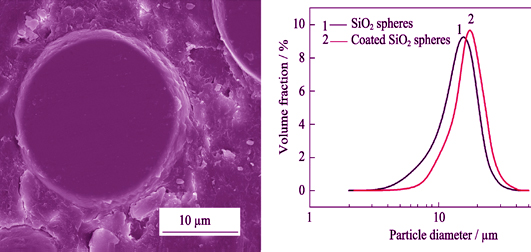
|
|